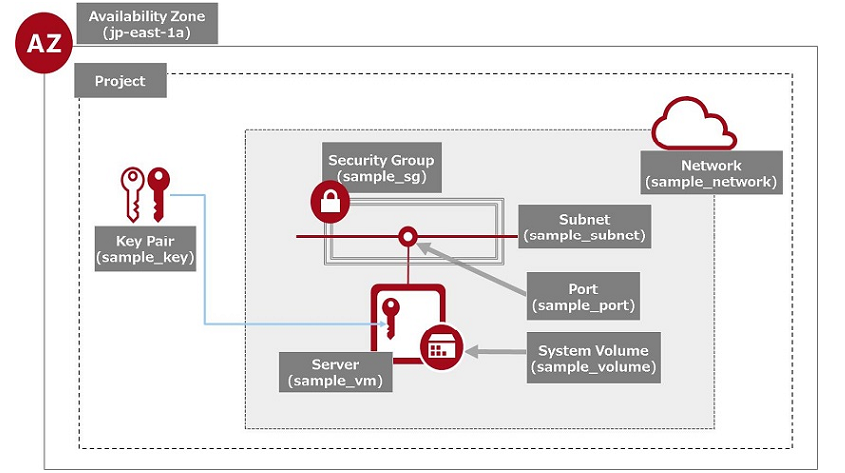Sample system configuration - Example Heat template
Heat_template_sample.yaml
Below is an example of a template for creating resources.

Heat_template_sample.yaml
#
# This is a hello world HOT template just defining a single compute
# server.
#
heat_template_version: 2013-05-23
description: >
This HOT template that just defines a single server and network.
Contains just base features to verify base HOT support.
parameters:
az:
type: string
description: availability zone
default: jp-east-1a
network_name:
type: string
description: name of network
default: sample_network
subnet_name:
type: string
description: name of subnet
default: sample_subnet
subnet_cidr:
type: string
description: subnet CIDR
default: 192.168.0.0/24
port_name:
type: string
description: name of vm
default: sample_port
sg_name:
type: string
description: security group
default: sample_sg
key_name:
type: string
description: name of keypair
default: sample_key
image:
type: string
description: Image ID or image name to use for the server
default: 383ed3f8-0773-4b14-96c8-feb387dd3935
volume_name:
type: string
description: name of volume
default: sample_volume
flavor:
type: string
description: Flavor for the server to be created
default: T-1
vm_name:
type: string
description: name of vm
default: sample_vm
resources:
network:
type: OS::Neutron::Net
properties:
name: { get_param : network_name }
availability_zone: { get_param : az }
subnet:
type: OS::Neutron::Subnet
properties:
name: { get_param : subnet_name }
network_id: { get_resource : network }
availability_zone: { get_param : az }
cidr: { get_param : subnet_cidr }
port:
type: OS::Neutron::Port
properties:
name: { get_param : port_name }
network_id: { get_resource: network }
availability_zone: { get_param: az }
security_groups:
- {get_resource: sg }
fixed_ips:
- subnet_id: { get_resource: subnet }
sg:
type: OS::Neutron::SecurityGroup
properties:
name: { get_param : sg_name }
rules:
# HTTP
- { direction: egress, ethertype: IPv4, port_range_min: 80, port_range_max: 80, protocol: tcp, remote_ip_prefix: 0.0.0.0/0 }
# HTTPS
- { direction: egress, ethertype: IPv4, port_range_min: 443, port_range_max: 443, protocol: tcp, remote_ip_prefix: 0.0.0.0/0 }
# DNS
- { direction: egress, ethertype: IPv4, port_range_min: 53, port_range_max: 53, protocol: tcp, remote_ip_prefix: 0.0.0.0/0 }
- { direction: egress, ethertype: IPv4, port_range_min: 53, port_range_max: 53, protocol: udp, remote_ip_prefix: 0.0.0.0/0 }
key:
type: OS::Nova::KeyPair
properties:
name: { get_param: key_name }
save_private_key: true
availability_zones: [{ get_param: az }]
sys-vol:
type: OS::Cinder::Volume
properties:
name: { get_param: volume_name }
size: 30
volume_type: "M1"
availability_zone: { get_param: az }
image : { get_param: image }
server:
type: OS::Nova::Server
properties:
key_name: { get_resource: key }
image: { get_param: image }
flavor: { get_param: flavor }
networks: ["port": {get_resource: port} ]
name: { get_param: vm_name }
block_device_mapping:
- device_name: vda
volume_id: {get_resource: sys-vol}
outputs:
private_key:
description: private key of created key pair
value: { get_attr: [key, private_key] }In this template, based on the system configuration, the virtual network and the virtual server are created inside the same stack, but to improve readability users are advised to divide resources to prevent inter-resource dependency.
In addition, dividing templates makes it possible to reduce the range of effect when an error occurs.
Regarding the example template for a virtual network and a virtual server, see below.